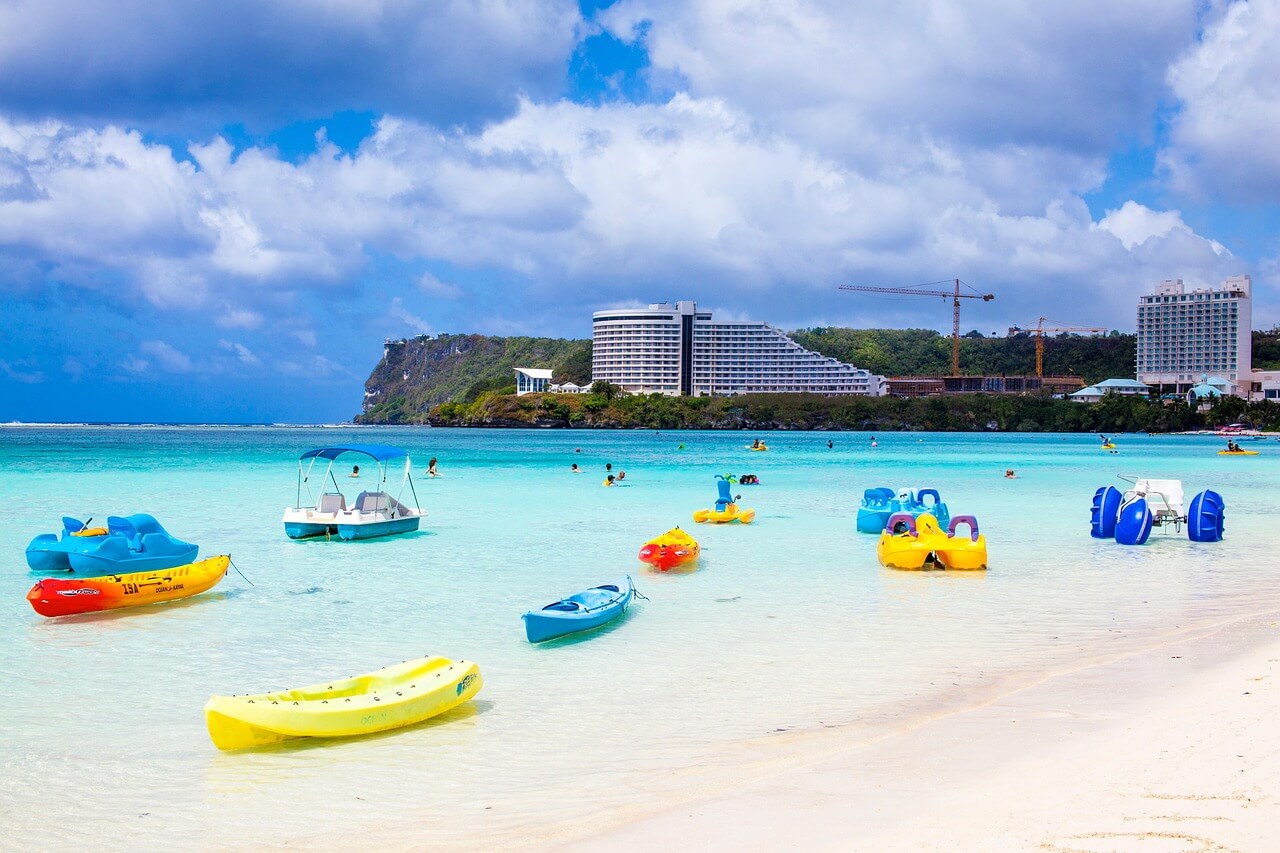When to visit Guam during the year?
Guam enjoys a tropical climate, characterized by warm temperatures and occasional rainfall all year round. The peak tourist season is during the dry months from December to June, where visitors flock to enjoy stunning beaches and vibrant cultural festivals. Summer (July to September) can see a spike in humidity and rain, but it's also when the island comes alive with local events, making it a lively time to visit. Autumn offers fewer tourists, making it an ideal time for peace and quiet while still enjoying beautiful weather.
How to get to Guam?
Reaching Guam is relatively straightforward, thanks to its major international airport, Antonio B. Won Pat International Airport (GUM). Here’s how you can get to Guam from various parts of the world:
- Main airports include Antonio B. Won Pat International Airport, which connects to major cities globally.
- Direct flights are available from the US, Japan, South Korea, Australia, and other countries.
- Low-cost airlines include Peach Aviation from Japan.
- Flight times vary; for example, a flight from Tokyo takes around 3.5 hours, while from Los Angeles it's about 12 hours.
- Buses are not a common mode of transport to Guam, but public transport is available on the island for local travel.
- Guam does not have a train system connected to other countries due to its island status.
- There are no major highways leading to Guam from other countries as it is an isolated island.
- Once on the island, you can explore by car, with key roads connecting popular destinations.
- Road conditions are good, and there are no tolls.
Tourist activities in Guam
Guam offers a rich tapestry of activities for diverse interests. For beach lovers, Tumon Bay is the go-to destination, famous for its clear waters and vibrant marine life, perfect for snorkeling and diving. History enthusiasts should not miss the War in the Pacific National Historical Park, where they can explore significant sites from World War II. The island also boasts beautiful hiking trails like those found in the (2) Ritidian Point where nature unfolds in lush landscapes. For cultural experiences, check out the Chamorro village market held every Wednesday night, where local crafts, street food, and concert performances create a lively atmosphere. Outdoor action also includes surfing at Ypao Beach and jet skiing in nearby waters. Nightlife in Guam can be vibrant, particularly around Tumon, featuring bars and nightclubs that showcase local music and dance.
Accommodation in Guam
Guam provides a wide range of accommodation options to suit different budgets. Luxurious resorts like the Hilton Guam Resort offer beachfront views and high-end amenities, while more budget-friendly hotels are available in Tumon, ranging from $100 to $200 per night. For travelers seeking a homely environment, vacation rentals, including apartments and villas, can be found, typically costing around $150 to $250 nightly. The busy season from December to April sees higher prices, while discounts can often be found during the off-peak months of the summer. Whatever your preference, Guam's diverse accommodations ensure comfort is within reach.
Food in Guam
Guam's culinary scene is a delightful mix of flavors influenced by its Chamorro heritage and Asian traditions. Signature dishes like Red Rice Cooked with Annatto and Chamorro Barbecue truly showcase local flavors. Don’t miss out on trying Kelaguen, a dish made from marinated meat served with lemon and coconut. For drinks, try the local coconut water or a tropical fruit shake. Restaurants and eateries range widely, from casual eateries serving island staples to finer dining options offering international cuisine. Expect to spend about $10 to $25 for a meal, depending on your choice of restaurant.
Important numbers and information
- Emergency Services: Police - 911, Ambulance - 911, Fire Brigade - 911
- Embassy Contact: US Embassy (Apra Heights, Guam)
- Antonio B. Won Pat International Airport: 355 Chalan Pasaheru, Tamuning, GU 96913
- Currency: US Dollar (USD)
- Payment Methods: Credit cards widely accepted, cash also common
- Visa/Passport: US citizens do not need a visa; others should check regulations before traveling.
What to see in Guam?
Guam’s attractions are rich in history and natural beauty. Must-see spots include the stunning cliffs at Two Lovers Point, offering breathtaking views of the ocean, perfect for sunset watchers. The historic site of Fort Apugan provides insight into the island's military past. For culture, the Latte Stone Park showcases the unique Chamorro stones that date back to ancient times. Don’t forget to explore the underwater paradise at the Guam Underwater World aquarium or take a tour at the Pacific War Museum. The beautiful beaches at Tumon and Gun Beach serve as relaxing spots for sunbathing. Each sight offers a unique glimpse into Guam's landscape and culture, making every visit memorable.
History, geography and climate
Guam's history is deeply intertwined with centuries of colonization, beginning with the arrival of the Spanish in the 16th century. The island played a strategic role during World War II, leaving lasting historical sites. Geographically, Guam is the largest island in Micronesia, featuring stunning beaches, coral reefs, and lush mountains. Its location in the western Pacific gives it a tropical climate, with average temperatures ranging from 77°F (25°C) in winter to 85°F (29°C) in summer. The island's diverse ecosystem is home to many marine species and vibrant natives, making it both a geographical and cultural gem.
Population and culture
Guam's population is about 170,000 people, with Chamorros being the indigenous people of the island. English and Chamorro are the official languages, reflecting a diverse cultural mix influenced by various nations. The majority of the population follow Christianity, with unique traditions celebrated throughout the year. Significant cultural events include the Liberation Day, honoring the island's freedom with parades and festivities. Guam is known for its hospitality, with customs reflecting a communal spirit and family importance. Festivals, music, and dance showcase the rich cultural heritage, making it a unique place to experience vibrant island life.








